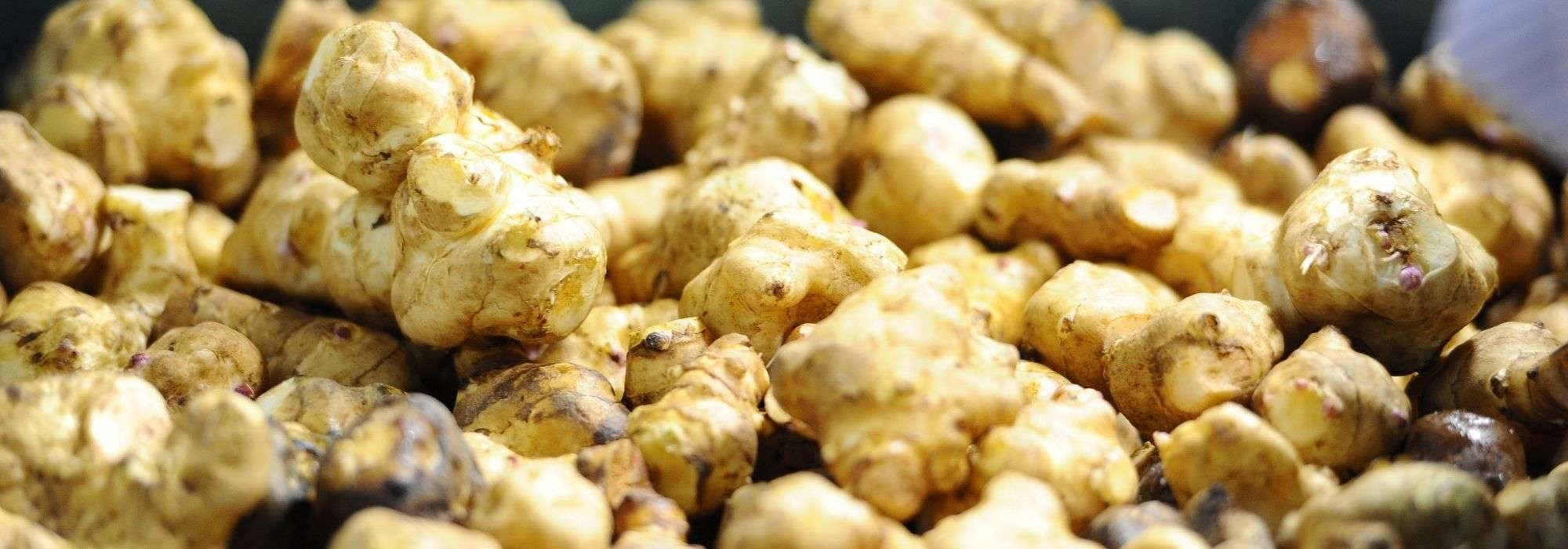
Jerusalem artichoke: planting, growing, harvesting
Contents
Jerusalem artichoke in a nutshell
- Jerusalem artichoke is a tuberous vegetable grown for its edible, irregularly shaped tuber that is pink or white in colour.
- Its flesh reveals a sweet flavour reminiscent of artichoke and can be consumed both raw and cooked.
- In summer, it produces sunny yellow flowers similar to small sunflowers, borne on sturdy, tall stems that can reach up to 3 metres high.
- It is one of the easiest vegetables to grow, thriving in any soil that is not too wet.
- It can be harvested as needed throughout winter, from November to March, and lends itself to numerous recipes.
A word from our expert
Associated with the Second World War, a period during which it replaced the potato that was requisitioned by the Germans, Jerusalem artichoke has been neglected for decades. Today, this unjustly forgotten root vegetable is making a well-deserved comeback in gardens and on our plates.
This knobbly tubercle with its light pink to beige flesh has a delicate, slightly sweet flavour reminiscent of artichoke. Easy to cook, it lends itself to numerous recipes; it can be prepared after cooking in gratins, sautéed in a pan, or mashed, or eaten raw, grated in mixed salads. Whether raw or cooked, it contains many benefits, particularly its high fibre content, which stimulates intestinal transit: it can sometimes be difficult to digest, leading to bloating and flatulence.
The Jerusalem artichoke is typically a winter vegetable, being one of the last vegetables harvested from the garden. Plant the tubers in March-April for a harvest from November to March! From planting to harvest, its cultivation is easy and low-maintenance.
Hardy and perennial, it has a great capacity to multiply ad vitam aeternam, hence its not entirely unfounded reputation as an invasive plant: to prevent it from taking over, be sure to allocate an appropriate space for it!
Rediscover this delicious ancient vegetable with an artichoke flavour!
Description and Botany
Botanical data
- Latin name Helianthus tuberosus
- Family Asteraceae
- Common name Jerusalem Artichoke, Sunchoke
- Flowering August-October
- Height 45 cm to 3 m
- Exposure Sun, Partial shade
- Soil type rich and light
- Hardiness -15°C
The Jerusalem Artichoke – Helianthus tuberosus – also known as Sunchoke, Earth Pear or Canada Truffle, is a perennial vegetable plant from the Asteraceae family, just like helianthe and sunflower. The Jerusalem artichoke was cultivated in the great plains, thickets, and roadside edges of central United States by Native American tribes, and it was not until 1607 that it was imported to France; it was quickly dethroned by the potato. It is grown for its misshapen edible tubers, whose fine flavour resembles that of artichoke, water chestnut, and salsify.
The genus includes over 70 species. Depending on the varieties, the root will develop a tuber with different shapes, skin colours, flesh colours, and flavours.
The Jerusalem artichoke produces knobby, fleshy roots called tubers, somewhat resembling ginger roots. Their shape varies from elongated spindle-shaped (spindle Jerusalem artichoke) to rounded or round (tubers ‘Patate’), from irregularly knobbly to smooth, with skin ranging from white-beige to reddish-purple (purple Jerusalem artichoke), depending on the variety. A tuber weighs on average between 50 to 100 grams.
This herbaceous perennial plant spreads very quickly from tubers, much like potatoes. The plant forms an erect clump from which rough, branched, hairy, and hollow stems often reddish in colour rise, reaching up to 2.50 to 3 m in height. The dwarf Jerusalem artichoke is an interesting variety that will not exceed 40 to 50 cm in height.
They bear deciduous pubescent foliage. The dark green, alternate leaves, measuring 10 to 20 cm long, are ovate to lanceolate, with serrated and undulating edges. Bristly with coarse hairs, they have a rough texture.
From August to October depending on the climate, the Jerusalem artichoke flowers, producing very pretty golden yellow flowers similar to those of the sunflower. Solitary or gathered in loose clusters, these little suns bloom in heads formed of a row of ligules surrounding a brown-yellow centre. These ray florets are characteristic of the Asteraceae family.
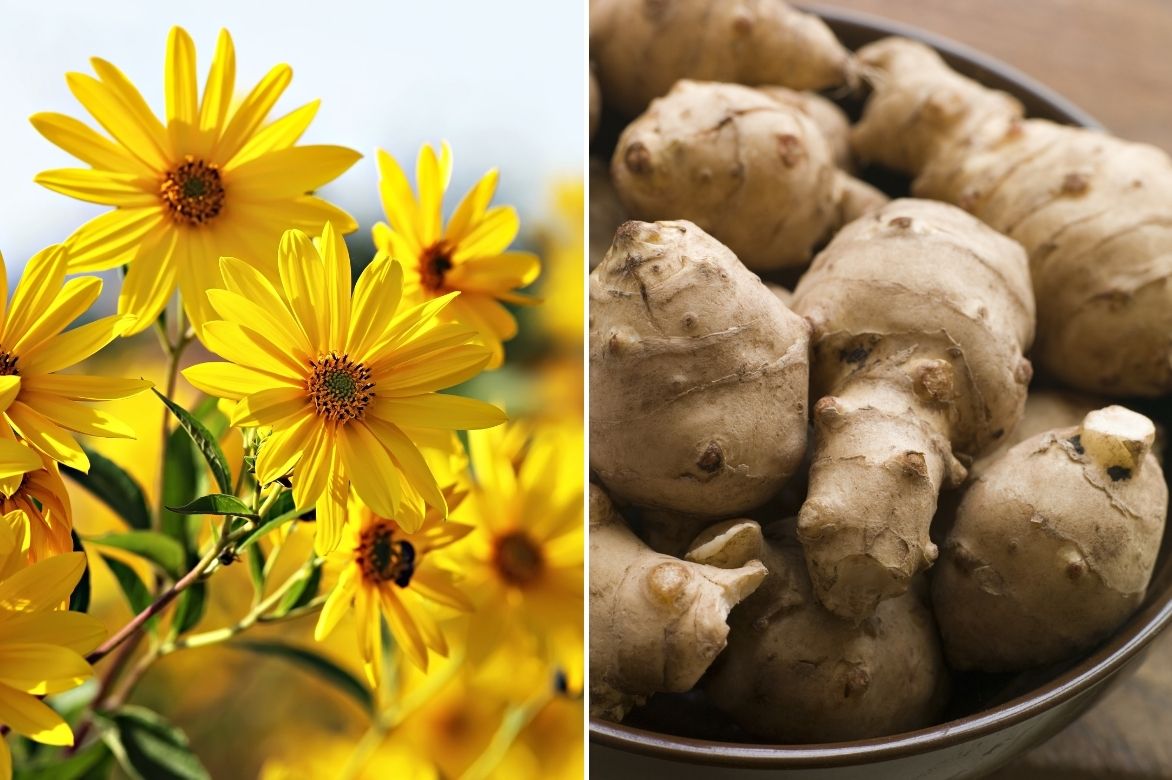 Jerusalem Artichoke : flowers and tubers[/caption>
Jerusalem Artichoke : flowers and tubers[/caption>
At the end of summer, after pollination, each flower gives rise to fruits, achene of a grey-brown colour highly appreciated by birds.
The Jerusalem artichoke is a very vigorous and undemanding root vegetable that had its heyday during the Second World War, when it was consumed as a rationing vegetable: potatoes were destroyed or requisitioned by the Germans. Neglected, it then completely fell into disgrace, perhaps associated with the heavy memory of those times of scarcity.
“`
Read also
Conserver les légumes du potagerMain species and varieties
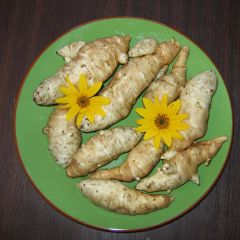
Jerusalem Artichokes - Helianthus tuberosus
- Flowering time October, November
- Height at maturity 2 m
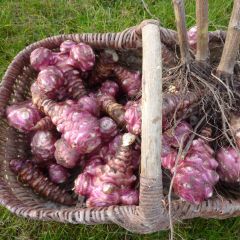
Organic Pink Jerusalem Artichokes - Helianthus tuberosus
- Flowering time October, November
- Height at maturity 2 m

Dwarf Organic Jerusalem Artichoke - Helianthus tuberosus
- Flowering time October, November
- Height at maturity 45 cm
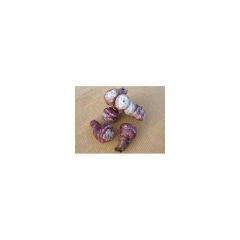
Purple Jerusalem Artichokes plants - Helianthus tuberosus
- Flowering time September, October
- Height at maturity 2 m
Discover other Jerusalem Artichokes
View all →Available in 1 sizes
Available in 1 sizes
Available in 2 sizes
Available in 1 sizes
Available in 1 sizes
Planting
Where to plant it?
Very hardy, the Jerusalem artichoke withstands frost and can be grown in almost all regions throughout the year, from November until the end of March. It can overwinter underground.
Easy to cultivate, the Jerusalem artichoke will grow in any type of soil, although it prefers light, fairly rich, well-drained soils. However, it dislikes overly wet soils, so ensure your soil is sufficiently draining. It should be planted in full sun or partial shade in a sheltered spot away from the wind. The tubers resist both frost and drought.
Choose its location carefully, as it tends to become quite invasive, spreading rapidly from year to year from any tubers left in place after harvest. With a rapid growth rate and the ability to reach nearly 3 m in height, it’s best to avoid planting it among other vegetables in the vegetable garden, where it may quickly overshadow them. Therefore, make sure to plant it away from other crops, at the edge of the vegetable patch, in a neglected corner of the garden, or as a summer hedge. Its place is not in the vegetable garden—unless you have a large plot—because it will quickly smother your other crops. Dwarf varieties can also be grown in a pot on the balcony or terrace, as well as in summer borders.
The Jerusalem artichoke is a vegetable that depletes the soil, as it is very nitrogen-hungry. It is important to rotate crops in the plots: wait 3 to 4 years before replanting in the same location.
When to plant the Jerusalem artichoke?
The Jerusalem artichoke has the advantage of being plantable almost all year round. Planting takes place in spring, from late February to June, or in autumn in September – October for a harvest throughout the winter, from November to March.
How to plant it?
A few months before planting, incorporate well-matured compost by scratching it into the top 5 cm after properly loosening the soil: the harvests will be more abundant in rich soil.
- Dig the soil before planting
- Plant the tubers in rows spaced about 60-70 cm apart, with a spacing of 40-50 cm between them
- Push them in to a depth of 10 cm, with the shoots pointing upwards
- Cover with soil
- Firm down and water
- Weed at the beginning of the growing season
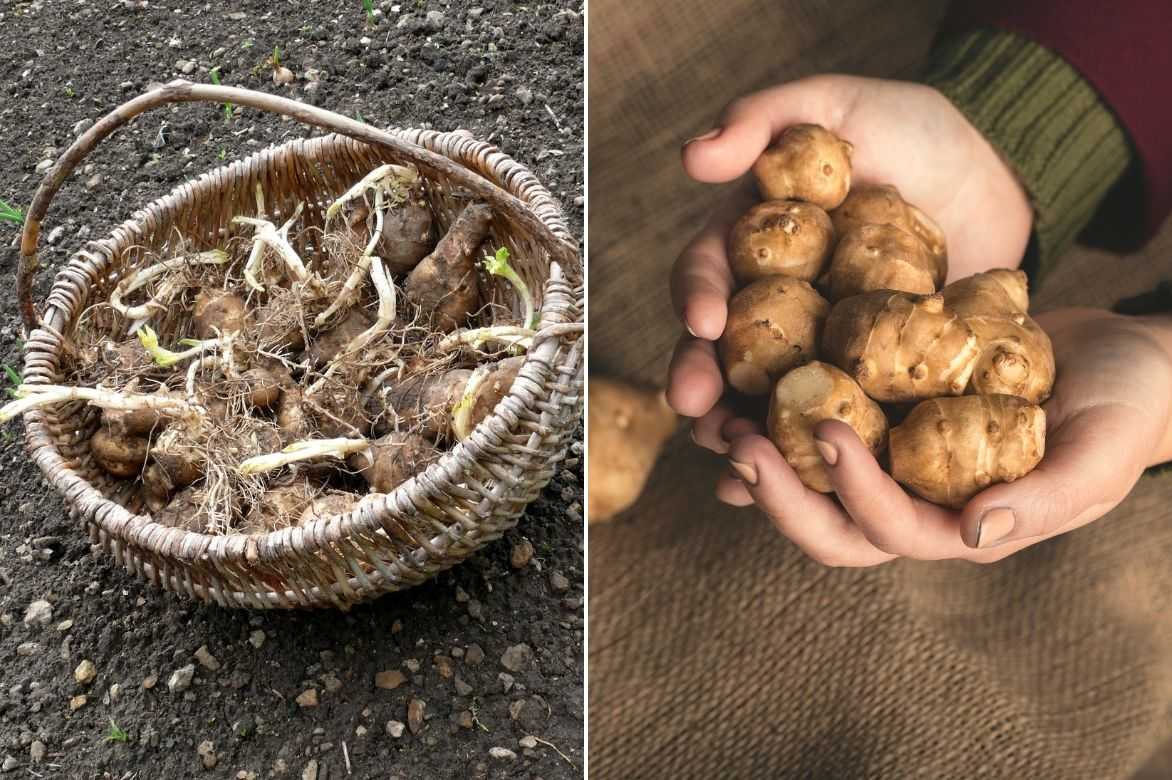
Maintenance, care and associations
The cultivation of Jerusalem artichoke is not complicated. Regular maintenance for Jerusalem artichoke involves weeding, hoeing, and watering. These tasks can be spaced out if you mulch the soil with fine layers of dried grass clippings or with fallen leaves, for example. A thick mulch will facilitate harvesting during the winter period, especially if the ground freezes.
Weed especially at the beginning of the cultivation and mound when the stems reach 20 cm in height, to help them anchor well and better withstand the wind. You can install stakes if necessary.
Watering is not necessary, except in cases of prolonged drought and high temperatures. Watering should be done sparingly to avoid rotting the tubercles.
As it generates a lot of shade, Jerusalem artichoke is not a good companion in the vegetable garden for neighbouring vegetable plants. Planting white clover between the young plants will help prevent the appearance of weeds.
Possible diseases
Vigorous and particularly resistant to diseases, the Jerusalem artichoke is truly only threatened by attacks from slugs and snails that are fond of its young shoots. Discover our 7 ways to fight slugs effectively and naturally and how to make a slug trap.
It can be targeted by aphids: sow nasturtiums near your Jerusalem artichoke plants, this tip will divert them. Spray a solution made from black soap to dislodge them.
At the end of summer, powdery mildew can leave a white fluff on the foliage. Avoid wetting the leaves when watering and follow our tips to limit the appearance of white disease.
Harvest and storage
When and how to harvest Jerusalem artichokes?
- The harvest: The tubercles are harvested 7 months after planting, from November to March, once the foliage has darkened: cut the foliage and flower stems, then lift the tubercles with a fork as needed. Cold and frost enhance the flavour of Jerusalem artichokes. The tubercles do not freeze, spread out the harvest and leave them in the ground as they do not store well. Note: any tubercle left in the ground will reappear the following year, ensuring a new crop.
- Storage: Once out of the ground, the tubercles do not keep for long. They can be stored for 2 to 3 days in the refrigerator or in a cool room after harvest. They also freeze very well after being peeled, washed, and dried.
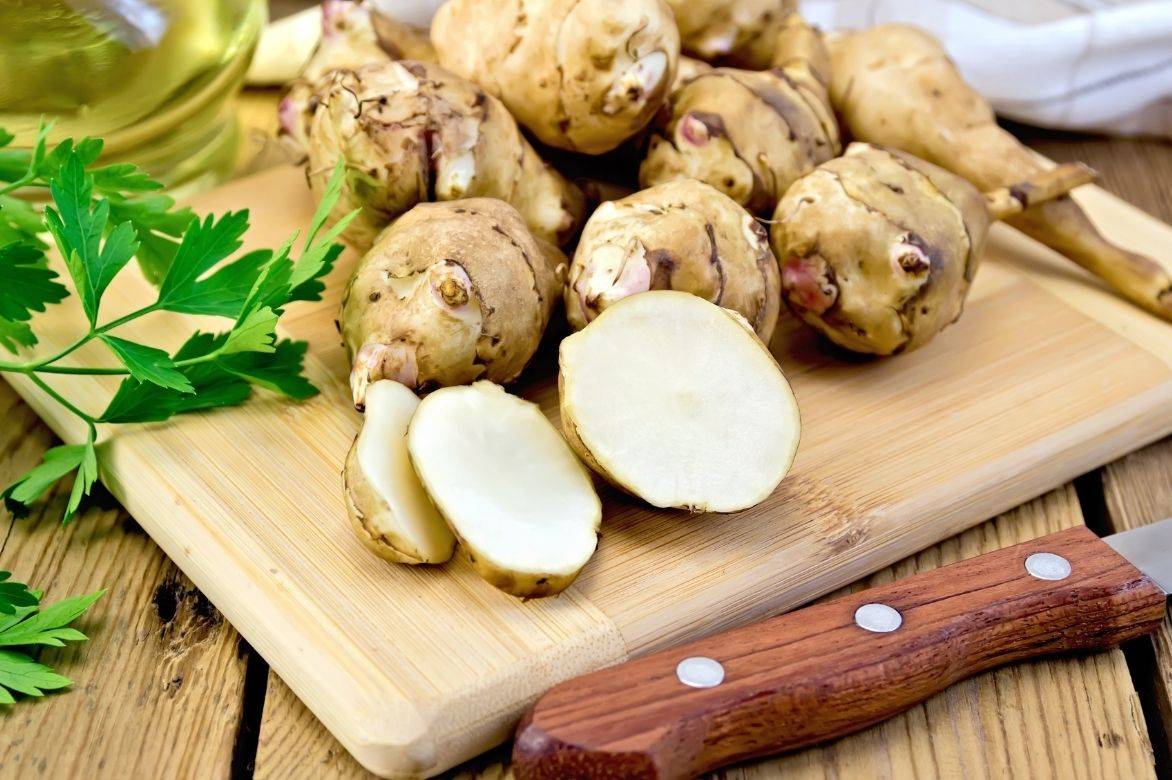
Uses and nutritional benefits
In the kitchen, the Jerusalem artichoke has a slightly sweet flavour reminiscent of artichoke hearts. It can be eaten raw, grated like carrots and dressed with vinaigrette, or cooked in a gratin, sautéed in butter, puréed, in soup, or braised. The skin should be peeled to enjoy the flesh. Consume it in small quantities as it has carminative properties and can sometimes be difficult to digest.
The Jerusalem artichoke also serves as forage for livestock. Rabbits also love its leaves and stems.
The Jerusalem artichoke is rich in vitamins (A, C, B1, B5) and minerals; including calcium, copper, iron, phosphorus, potassium, sulphur, zinc, and magnesium. It does not contain starch but a carbohydrate that does not disrupt the blood sugar levels of diabetic individuals, making it an ideal root vegetable for those with diabetes.
Useful resources
- Discover in our online shop our range of tuberculate Jerusalem artichokes
- Among the heritage vegetables: the Jerusalem artichoke, a forgotten vegetable to rediscover
- Subscribe!
- Contents
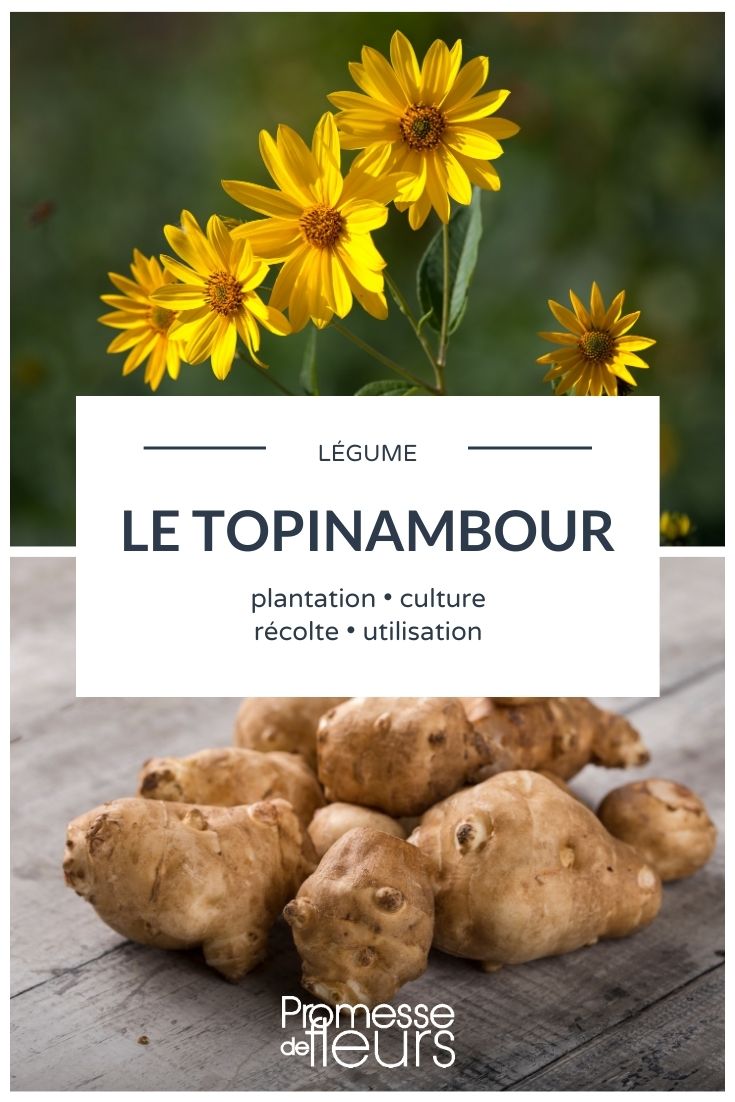


































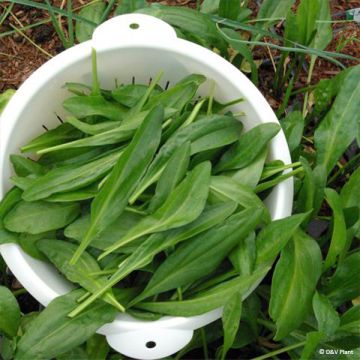

Comments